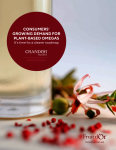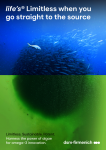Omega-3 EPA linked to improved gullet health
(EPA) may improve the fatty acid levels composition in the gullet,
and reduce the risk of cancer, suggests a new study.
"After six months of dietary supplementation with EPA, we observed important changes in the fatty acid composition of Barrett's mucosal epithelium," wrote lead author Samir Mehta in this month's issue of the American Journal of Clinical Nutrition. "To our knowledge there has been no previous investigation of the effects of supplementation with PUFAs on the fatty acid composition of the human esophageal mucosa." Barrett's oesophagus is cause by acid reflux, and although it can occur early in life, most sufferers are in their 40s and 50s. Although it has been reported to be a precursor to oesophageal cancer, 90 per cent of patients are said to never develop cancer, and although some speculation as to dietary and drug history, the reason why this is so is not really known. "The incidence of oesophageal adenocarcinoma in Europe and the United Kingdom has increased considerably over the past 20 years, with an increase per annum greater than that of any other malignancy," explained the researchers. The study adds to a small but growing body of science reporting the potential anti-cancer benefits of the marine fatty acids, previously linked to reduced risks of colorectal, prostate and liver cancer. Study details Researchers from the Norfolk and Norwich University Hospital and the Institute of Food Research recruited participants with known Barrett's oesophagus and randomly assigned 27 patients (average age 64) to receive daily EPA supplements (three 500 mg capsules per day, SLA Pharma, United Kingdom) and 19 patients (average age 65) to no supplement (control group) for six months. "In the present study we used a commercially available concentrated n-3 formulation containing EPA in the form of free fatty acid, rather than as a triglyceride, because it was felt that this might offer an advantage with regard to the efficiency of delivery of EPA to the target tissue," explained Mehta and co-workers. At the end of the study, biopsies were taken in order to measure fatty acid levels in the tissue, while markers of inflammation were also quantified. Promising results The Norwich-based researchers report a significant increase in the EPA content of the oesophageal tissue in the EPA group (1.6 per cent increase), compared to control (zero increase). Additionally, levels of the COX-2 protein also significantly decreased in the EPA group, while there was a slight increase in the control group. The change in COX-2 protein levels was inversely related to changes in the EPA content of the tissue, said the researchers. COX-2 is an enzyme which is linked to the inflammatory process. On the other hand, no changes in other inflammation markers, such as prostaglandin E2 and leukotrieneB4, were recorded. "We were unable to show a significant decrease in epithelial cell proliferation, but the reduction in COX-2 protein concentrations that we observed suggests that n-3 PUFAs, perhaps at higher concentrations of supplementation, might have a role to play in chemoprevention in patients with dysplasia, in whom there is a higher baseline proliferation index with increased COX-2 expression," wrote the researchers. "Moreover, the long-term maintenance of relatively high concentrations of n-3 PUFAs in the oesophageal mucosa, which might be expected in populations with a habitually high consumption of oily fish, may inhibit the expression of COX-2 and thereby inhibit either the development or the progression of Barrett's oesophagus in the community. "Further studies on the potential chemopreventive effects of marine oils therefore seem warranted," they concluded. Increased interest in Barrett's oesophagus The rise in the incidence of oesophageal cancer in Europe has seen an increase interest in researcher potential nutritional prevention approaches. In 2008 alone, researchers from Ohio State University and the Blueberry and Cranberry Research Center at Rutgers University reported potential benefits from proanthocyanidins-rich cranberry extract, while researchers from Kaiser Permanente Northern California and the University of California reported that a diet rich in fruit and vegetables was associated with a 65 per cent reduction in the occurrence of Barrett's oesophagus. Source: American Journal of Clinical Nutrition April 2008, Volume 87, Pages 949-956 "Effect of n-3 polyunsaturated fatty acids on Barrett's epithelium in the human lower esophagus" Authors: Samir P. Mehta, A.P. Boddy, J. Cook, V. Sams, E.K. Lund, I.T. Johnson, M. Rhodes












